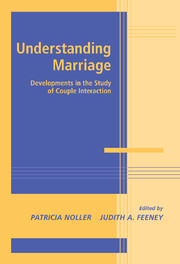Book contents
- Frontmatter
- Contents
- Contribitors
- Introduction
- SECTION ONE THE EFFECT OF COGNITION ON INTERACTION PATTERNS
- SECTION TWO UNDERSTANDING THE IMPORTANCE OF POSITIVE INTERACTION
- SECTION THREE COPING WITH DISAPPOINTMENT, CRITICISM, AND BETRAYAL
- Introduction to Section Three
- 8 Coping with Disappointment in Marriage: When Partners' Standards Are Unmet
- 9 On Empathic Accuracy and Husbands' Abusiveness: The “Overattribution Bias”
- 10 The War of the Roses: An Interdependence Analysis of Betrayal and Forgiveness
- SECTION FOUR POWER, CONFLICT, AND VIOLENCE IN MARITAL INTERACTION
- Marital interaction at important transition periods
- SECTION SIX Interventions for strengthening relationships
- Conclusions
- Index
Introduction to Section Three
Published online by Cambridge University Press: 25 July 2009
- Frontmatter
- Contents
- Contribitors
- Introduction
- SECTION ONE THE EFFECT OF COGNITION ON INTERACTION PATTERNS
- SECTION TWO UNDERSTANDING THE IMPORTANCE OF POSITIVE INTERACTION
- SECTION THREE COPING WITH DISAPPOINTMENT, CRITICISM, AND BETRAYAL
- Introduction to Section Three
- 8 Coping with Disappointment in Marriage: When Partners' Standards Are Unmet
- 9 On Empathic Accuracy and Husbands' Abusiveness: The “Overattribution Bias”
- 10 The War of the Roses: An Interdependence Analysis of Betrayal and Forgiveness
- SECTION FOUR POWER, CONFLICT, AND VIOLENCE IN MARITAL INTERACTION
- Marital interaction at important transition periods
- SECTION SIX Interventions for strengthening relationships
- Conclusions
- Index
Summary
Although there has been a long history of researchers focusing on conflict in marital relationships, the area of study known as the “dark side of relationships” has been a more recent development. This area tends to focus on a number of relatively neglected behaviors and emotions, such as disappointment, rejection, neglect, betrayal, and infidelity. The dynamics associated with these kinds of relationship events are likely to be very complex; different kinds of responses from one partner may have very different effects on the emotions experienced by the other partner, and on the future of the relationship.
We all enter relationships with expectations about how partners should treat us, and about how we should benefit from being in the relationship. These expectations and standards guide our evaluations of our relationships. In all relationships, however, there are occasions when these standards are not met. How we respond to such occasions will inevitably have an impact on our satisfaction with our relationships.
Vangelisti and Alexander present an inductive analysis of responses to disappointment in marriage. This analysis highlights the wide variety of possible responses to unmet standards, including such diverse coping strategies as anger, self-disparagement, getting even, ignoring the event, trying to revitalize the relationship, believing the partner will change, and seeking intervention from a third party. The authors describe how these strategies differ in terms of five important dimensions: expression versus suppression of distress, focusing on the self versus the partner, recognition of the unmet standard versus rationalization, relationship versus network as the locus for action, and constructive versus destructive outcomes.
Information
- Type
- Chapter
- Information
- Understanding MarriageDevelopments in the Study of Couple Interaction, pp. 197 - 200Publisher: Cambridge University PressPrint publication year: 2002
